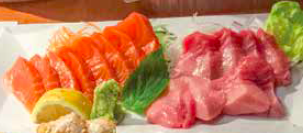For Japanese cuisine on the Cape, Inaho has flourished — even at a time when no one had heard of sushi
Cape Cod Magazine, October 2017
At least twice a week, Inaho’s owner/chef Yuji Watanabe makes an early morning trip to Boston’s fish markets—where he shops for the freshest local seafood. He’ll purchase a whole salmon, tuna or whitefish to serve in the restaurant that night. “He’s a fanatic about freshness,” says his wife, Alda Watanabe. “If it’s not in season, it just doesn’t taste right.”
The Watanabes opened Inaho on April 28, 1989, originally on Main Street in Hyannis. Alda says that while sushi was embraced by some, it was a difficult start. “People were like, ‘Raw fish? No thank you,’” laughs Alda. She says that when they moved their restaurant to Yarmouth Port in 1992, people would say, “You’re crazy, opening a Japanese restaurant in little Yarmouth Port!”

The Watanabes met in 1988 in Newport, Rhode Island, where Yuji was a sushi chef. “I’d gone out for sushi and he was the one who made my food,” Alda says fondly. Before then, Yuji had been a sushi chef in New York City for more than 10 years. Originally from Miyagi Prefecture, about 100 miles north of Tokyo, Yuji has done his share of traveling, including, in his 20s, bicycling around Australia for a year. After he and Alda met, they decided to quit their jobs—his as a sushi chef in Newport, hers at a car dealership—move to Cape Cod and open a Japanese restaurant. Alda says it took a couple of years to build a clientele. But little by little, people would try sushi.

Today, Inaho flourishes, with a waiting list for a table nearly every night. It’s been a family affair. The Watanabes have two sons—Hayato, now 26 and studying to be a lawyer at the University of Michigan; and Hiroto, 20, a pre-med student at Tufts University. They grew up with Inaho. “For them, there was school and a lot of Inaho time.” It was tough work, Alda says. “Sometimes we’d work six days a week throughout the year. We’d be lucky to squeeze in the beach for 15 minutes.”
According to Alda, one of the most popular dinner items, is scallops and lemon. A whole lemon or lime is hollowed out and cut in half. Scallops are mixed in spicy mayo sauce with roe and placed inside the hollowed-out lemon cup. For appetizers, customers love the eggplant with sweet, hot miso on top. “It bubbles up and it’s served piping hot,” says Alda, adding that traditionally Japanese cuisine is ordered for the table, like ordering a bunch of appetizers and sharing. “We bring it out as it’s made, so it’s not just sitting around.”
Popular sushi rolls are the dragon rolls—orange, red or double dragon. The Sophia roll has a seafood mix topped with sliced maguro and crispy fried onions with a spicy garlic ponzu sauce. Another customer favorite is shrimp and veggie tempura. The word Inaho means “ear of rice.” Alda explains: “Each kernel, as it bends over, and it’s heavy, means a good harvest, abundance. If there’s no rice in the house, you can’t do anything.”

–Marina Davalos

